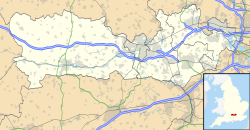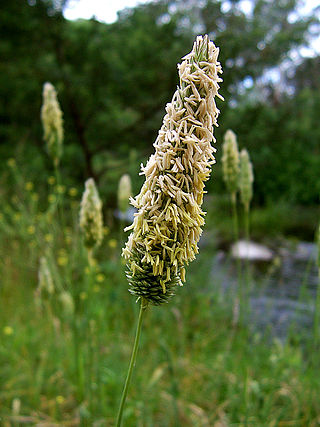
Poaceae or Gramineae is a large and nearly ubiquitous family of monocotyledonous flowering plants commonly known as grasses. It includes the cereal grasses, bamboos and the grasses of natural grassland and species cultivated in lawns and pasture. The latter are commonly referred to collectively as grass.
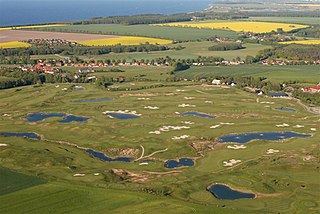
A golf course is the grounds on which the sport of golf is played. It consists of a series of holes, each consisting of a tee box, a fairway, the rough and other hazards, and a green with a cylindrical hole in the ground, known as a "cup". The cup holds a flagstick, known as a "pin". A standard round of golf consists of 18 holes, and as such most courses contain 18 distinct holes; however, there are many 9-hole courses and some that have holes with shared fairways or greens. There are also courses with a non-standard number of holes, such as 12 or 14.
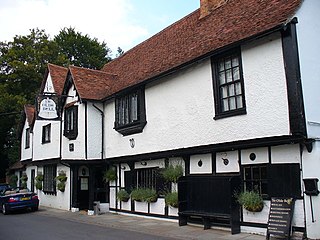
Hurley is a village and rural civil parish in Berkshire, England. Its riverside is agricultural, except for Hurley Priory, as are the outskirts of the village. The Olde Bell Inn adjoining the priory is believed to date from 1135.
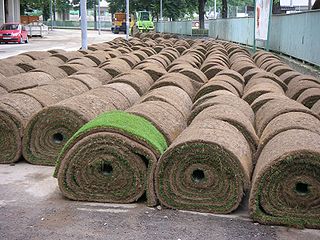
Sod, also known as turf, is the upper layer of soil with the grass growing on it that is often harvested into rolls.
The following is a glossary of the terminology currently used in the sport of golf. Where words in a sentence are also defined elsewhere in this article, they appear in italics. Old names for clubs can be found at Obsolete golf clubs.
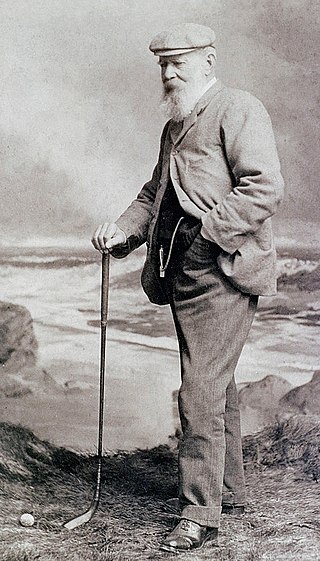
Thomas Mitchell Morris, otherwise known as Old Tom Morris, and The Grand Old Man of Golf, was a Scottish golfer. He was born in St Andrews, Fife, the "home of golf" and location of the St Andrews Links, and died there as well. Young Tom Morris, also a golfer, was his son.
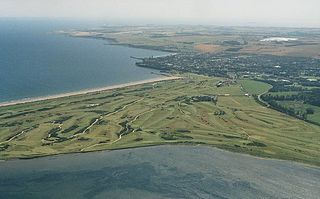
A links is the oldest style of golf course, first developed in Scotland. Links courses are generally built on sandy coastland that offers a firmer playing surface than parkland and heathland courses.
Sir Michael Francis Bonallack, OBE is an English amateur golfer who was one of the leading administrators in world golf in the late 20th century.

Newtimber is a small village and civil parish in the Mid Sussex District of West Sussex, England. It is located north-west of Brighton. The parish also includes the hamlet of Saddlescombe. The parish lies almost wholly with the South Downs National Park, with the exception of a small section of the parish north of the B2117 road. The planning authority for Newtimber is therefore the South Downs National Park Authority (SDNPA), the statutory planning authority for the National Park area. The downland scarp, which includes Newtimber Hill, Newtimber Holt, Saddlescombe chalk quarry and Summer Down, is mostly part of the Beeding Hill to Newtimber Hill, designated Site of Special Scientific Interest.

Archibald Simpson was an American professional golfer. He was also a golf course designer and a golf club maker. He was runner-up in The Open Championship in 1885, and 1890.
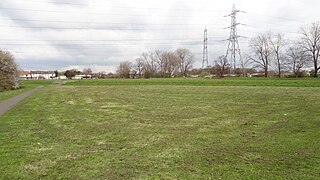
Mitcham Common is 182 hectares (460 acres) of common land situated in south London. It is predominantly in the London borough of Merton, with parts straddling the borders of Croydon and Sutton. It is designated a Site of Metropolitan Importance for Nature Conservation.
Turf management or pitchcare describes the work needed to keep a sporting pitch ready for use. This article looks at the various types of sporting pitches and the type of challenges which they present.
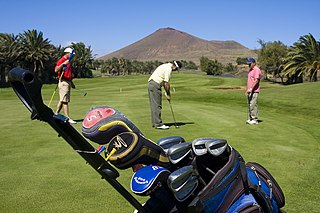
Golf equipment encompasses the various items that are used to play the sport of golf. Types of equipment include the golf ball, golf clubs, and devices that aid in the sport.

A greenskeeper is a person responsible for the care and upkeep of a golf course.

A hybrid is a type of club used in the sport of golf with a design borrowing from both irons and woods while differing from both. The name "hybrid" comes from genetics to denote a mixture of two different species with desirable characteristics of both, and the term here has been generalized, combining the familiar swing mechanics of an iron with the more forgiving nature and better distance of a wood.
Arthur James Lacey was an English professional golfer who finished in the top ten of The Open Championship on four occasions in the 1930s. He also played in the 1933 and 1937 Ryder Cup matches, and was then selected as non-playing captain of the Great Britain and Ireland side for those matches in 1951. He was chairman of the PGA from 1949 to 1951.
"Tee Off, Mr. Bean" is the twelfth episode of the British television series Mr. Bean, produced by Tiger Aspect Productions and Thames Television for Central Independent Television. It was first broadcast on ITV on 20 September 1995.

Royal West Norfolk Golf Club is a golf club in Brancaster, Norfolk, England, about 7 miles (11 km) east of Hunstanton, between Brancaster Bay and the salt marshes. The links course opened in 1892. Simon Rayner is a professional at the club. The "Royal" club name is named after Edward VII, who was the Prince of Wales at the time of opening.

Fernbrae Meadows is a public greenspace in South Lanarkshire, located on high ground to the south of Rutherglen, specifically directly south of the Fernhill neighbourhood. It is a proposed local nature reserve.

Raymond Harry Oppenheimer was an English businessman, golfer and Bull Terrier enthusiast. His family was wealthy from its interests in South African diamond mining. During World War II he became a wing commander in the Royal Air Force. In 1951 he was captain of the British team in the Walker Cup.

